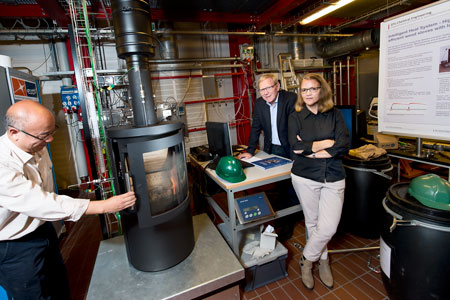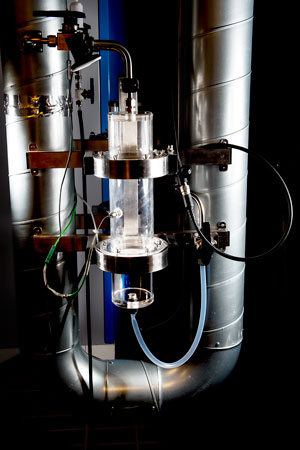The experience gained over many years of research in combustion has been put to good use by the Danish producer of wood-burning stoves
HWAM A/S in connection with the development of the first electronically controlled wood-burning stove on the market.
Winter is drawing near, which means that 750,000 Danish homes will once again be lighting their wood-burning stove. Kindlings, logs and a match is all you need to create the world's cosiest source of heat. Unfortunately, it is also a source of considerable air pollution. Wood-burning stoves of an earlier date and poor firing methods are to blame for the emission of a series of air pollutants during combustion. Even modern stoves and sound knowledge of proper firing methods rarely ensure maximum energy utilization of the wood.
These problems have spurred an intense public debate, and it has been questioned whether wood-burning stoves should even exist, which poses a major challenge for producers of wood-burning stoves.
"All the talk about air pollution in the suburbs affected our business, so we decided to find a solution to the problems," says Vagn Hvam, who founded HWAM A/S in 1973.
"We came up with the idea of controlling the combustion process by means of electronics, but after a couple of years of developing the system, we realized that we needed more competencies—more knowledge of the complex combustion process—to move things forward. Therefore, we contacted DTU where Kim Dam-Johansen (Professor, Head of Department at DTU Chemical Engineering and, according to Thomson Reuters, the world's most cited researcher within combustion in 1998-2008, ed.) said our idea offered strong potential."
Stages and pitfalls
It requires almost superhuman powers—or at least constant monitoring of the combustion process—to regulate the air supply and ensure precise combustion, preventing the emission of particles, volatile organic compounds and carbon monoxide (CO) at the same time as ensuring sufficient utilization of the firewood. "Environmentally conscious combustion means ensuring a sufficient oxygen level. In case of oxygen deficiency, volatile organic compounds will not be combusted and can subsequently—even immediately—condense into hazardous particles in the chimney," says Project Manager and Senior Adviser Jytte Boll Illerup from DTU Chemical Engineering, who has more than 25 years of experience researching combustion and emissions.
"Too much air, on the other hand, will reduce efficiency and thus result in poor utilization of the firewood. Our studies show that optimal control of combustion in a wood-burning stove is virtually impossible if done manually. This is where HWAM's automatic control system proves to be very helpful."
In the DTU Chemical Engineering test hall, each stage of combustion in the wood-burning stove is carefully monitored—from arranging the firewood to removing the ashes. This takes place using a unique particle collection system, which makes it possible to view and analyse the composition and size of the particles in the different stages of combustion: lighting stage, flame stage and coke stage.
"Time, temperature and turbulence—these are the three parameters that need to be controlled very carefully to ensure optimal combustion."
Jytte Boll Illerup, Project Manager and Senior Adviser at DTU Chemical Engineering
"Time, temperature and turbulence—these are the three parameters that need to be controlled very carefully to ensure optimal combustion," says Jytte Boll Illerup. "Which definitely isn't easy without any measuring instruments. It isn't always possible to estimate whether oxygen and temperature levels are sufficient, and whether the correct amount of draught is supplied through the chimney."
This is where HWAM's electronically controlled stove comes into the picture. The three air intakes in the stove are regulated by motorised dampers which open and close by means of a data program based on measurements of the room temperature as well as the temperature and level of oxygen in the flue gas. The user simply needs to set the required room temperature on the remote control, and the user will then be notified when it is time to refuel the stove.
Significant emission and efficiency improvements
When the first version of the autopilot was ready in 2012, DTU arranged for five private wood-burning stove users to test it. Measuring equipment was installed in their homes, and the users were asked to use their stove in the same way as they normally did. After a week, they were given a stove an integrated autopilot, and were asked to fire it in the way they normally did—e.g. they should use the same kind of firewood.
"The measurements showed a significant improvement in combustion when using our system, including reduced emissions of uncombusted gases and reduced fuel consumption," says Vagn Hvam. "But when the users were interviewed about the whole experience, they particularly underlined the comfort. It was so much easier to light the stove and maintain a stable room temperature."

In the test hall, the stoves are fired under controlled conditions using online measurements of the most essential process parameters as well as the O2, CO, CO2, NOx, SOx gas components and volatile organic compounds in the flue gas. In addition, particle emissions are determined according to various principles. From left: Weigang Lin, Associate Professor, DTU Chemical Engineering, Vagn Hvam Pedersen, founder of HWAM A/S, and Jytte Boll Illerup, Project Manager and Senior Adviser, DTU Chemical Engineering.
Article from DYNAMO no. 39, DTU's quarterly magazine in Danish.

Out of the total project budget of DKK 13.2 million, the collaboration between HWAM and DTU has been granted DKK 6.6 million by the Danish Energy Agency through the Energy Technology Development and Demonstration Programme (EUDP).
"The project is a classic example of how to spend EUDP funds," says Jan Bünger, Project Consultant from the EUDP Secretariat at the Danish Energy Agency. "Wood is a sustainable source of energy, but the energy efficiency of wood-burning stoves needs to be improved and particle pollution reduced. These are the challenges addressed by the project, and the collaboration with DTU has contributed to increased technological knowledge within the small company and laid the foundations for more green businesses."